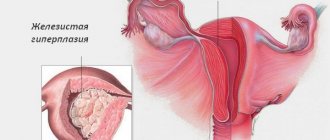Can there be brown discharge after menstruation?
The excretory system in the female body functions under the influence of hormones. Throughout the entire cycle, vaginal secretion changes its color and consistency. A characteristic sign of menstruation is bloody discharge. They are the result of decreased levels of progesterone in the body. Normally, such discharge should have a scarlet, pinkish or dark red tint. They may turn brown in the last days of your period. It is possible to determine whether brownish discharge after menstruation is a pathology only after a gynecological examination.
Why is the discharge brown?
The biological fluid turns brown when impurities of coagulated blood enter it. It is the blood that is responsible for the color, and depending on its concentration, the shade of the discharge can vary from pale brown to almost black. Thus, it becomes obvious that the cause of the brown secretion is the source of bleeding.
That is why all women faced with this problem are strongly recommended to visit a gynecologist as soon as possible in order to exclude the presence of serious internal damage and injuries, as well as to establish the true cause of bleeding.
Why do I have brown discharge after my period?
The work of the excretory system is always associated with internal processes. The causes of brown spotting after menstruation can be both physiological and pathological. In the first case, the change in color of the discharge is due to the oxidation of menstrual blood under the influence of oxygen. Because of this, the discharge takes on a brown tint. If the symptom is accompanied by an unpleasant odor, itching and pain in the abdomen, the cause of the discharge may be pathological. Factors that provoke the appearance of brown spotting include:
- endometriosis;
- ectopic pregnancy;
- damage to the vaginal mucosa;
- the presence of polyps in the uterus;
- infectious diseases;
- uterine hyperplasia;
- myoma;
- inclination of the cervix.
Brown discharge after period for several days
Doctors do not always consider brown discharge at the end of menstruation a deviation. If they only last a few days and do not cause discomfort, there is no need to worry. Typically, such discharge indicates the end of the critical days. A small amount of blood may stagnate in the pelvis due to a pathology in the structure of the uterus, for example, when it is bent. The blood has time to clot. For this reason, it is distinguished by a dark shade.
Brown discharge 5 days after period
The appearance of blood 4-5 days after the end of menstruation is a serious reason to consult a doctor. Such discharge is not associated with menstruation. The deviation may be accompanied by the following symptoms:
- unpleasant odor;
- abdominal pain;
- increase in body temperature;
- the presence of clots;
- burning and itching in the vagina.
Under certain circumstances, brown discharge occurs as a result of a ruptured follicle. If blood appears 5 days after menstruation, we are talking about early ovulation. Due to rupture of the follicle walls, blood vessels are damaged. This results in the release of a few drops of blood. At the moment the ovulatory fluid leaks into the abdominal cavity, the woman notices pain in the abdomen.
Spotting after menstruation for a week
Spotting after menstruation, lasting for a week, most often appears with endometriosis. The disease is accompanied by pathological growth of the endometrium outside the uterus - on the rectum, fallopian tubes and bladder. The reasons for its appearance include:
- surgical intervention;
- disruption of hormone production;
- formation of a focus of inflammation in the pelvic organs;
- hereditary predisposition.
Spotting a week after menstruation
The formation of a pathological process may be indicated by dark discharge after menstruation, which appears a week later, which indicates the formation of a pathological process. They can occur due to a lack of hormones or as a result of an inflammatory process. Such discharge is not the norm. To identify the cause of their formation, a gynecological examination is performed. To combat inflammation, women are prescribed antibiotics, and in case of hormonal imbalance, oral contraceptives are prescribed.
Brown discharge 10 days after period
Brown discharge after menstruation appears after 10 days. To determine the cause of their appearance, it is advisable for a woman to pay attention to the following parameters:
- volume of discharge;
- smell;
- color;
- accompanying symptoms.
Brown clots after menstruation are a sign of an inflammatory process or a bend of the uterus. In this case, menstrual blood cannot come out completely during menstruation. It curls up and darkens, and then is released throughout the cycle. If blood appears after sexual intercourse, the cause is erosion or other formations on the walls of the vagina.
Brown discharge after period after 2 weeks
If the woman is completely healthy, they may indicate attachment of the embryo to the uterine cavity. This phenomenon is called implantation bleeding. It usually appears 7-12 days after ovulation. Implantation does not pose any danger to a future pregnancy.
When is daubing normal?
The average duration of menstruation is up to 7 days. Towards the end, the blood is released more slowly, coagulates and turns brown. Vaginal discharge is considered normal; it tells a woman about health problems. If everything is in order, the secretion is the same throughout the entire cycle. Each phase of the monthly cycle is accompanied by a certain type of discharge, and it should not cause any discomfort. According to doctors, the norm is a few bloody drops on the underwear; they do not have an unpleasant odor and do not cause itching or burning.
A few days after your period, the spotting should stop. If this does not happen, you should visit a gynecologist. A healthy woman has a mucous secretion, often having a cloudy tint. Such secretions come out in small quantities, cleansing the genitals. Some girls notice a yellowish secretion, especially if they have not changed their underwear or panty liner for a long time. This occurs due to the interaction of secretion with oxygen and is not considered a pathological phenomenon.
If deviations are noticeable, the daub does not go away for too long and causes discomfort, perhaps the cause is a disease or hormonal imbalance. There are many provoking factors for spotting after menstruation; it is important to analyze them in more detail in order to sound the alarm in time.
Types of spotting after menstruation
The nature of vaginal secretion is considered to reflect the work of a woman’s reproductive organs. To detect problems in time, you need to pay attention to the color, consistency and smell of menstrual flow. It is recommended to record the results of observations in a separate notebook. This information will help the doctor make the correct diagnosis.
There are several types of spotting. Based on their shade, they are divided into the following types:
- dark;
- light brown;
- yellow-brown;
- black;
- brown.
Attention is also paid to the consistency of vaginal secretions. It may be watery, slimy, foamy, or containing clots. Normally, any inclusions in menstrual blood should be completely absent.
Dark discharge after menstruation
Brown discharge after menstruation often occurs due to severe inflammation of the uterus. Its occurrence is provoked by stagnant processes or infectious diseases. Treatment is carried out in a hospital setting. It includes the following:
- taking antibacterial agents;
- attending physiotherapeutic procedures;
- sanitation of the genital tract;
- use of antispasmodics;
- taking immunomodulators and vitamin supplements.
Light brown discharge after menstruation
Light spotting is within the normal range if it lasts no more than 2 days. It represents the remains of the endometrium formed in the previous cycle. For some women, labor discharge precedes the next menstruation. This is not considered a pathology. The light color is due to the low concentration of blood in the vaginal lubrication.
How does hygiene affect
One of the reasons for spotting after menstruation is neglect of the rules of personal hygiene, which contributes to the increased proliferation of pathogenic bacteria inside the vagina. To avoid the formation of infection, it is necessary to adhere to certain sanitary principles during critical days:
- washing the genitals after visiting the toilet;
- daily showering with cosmetics;
- timely replacement of gaskets;
- correct use of tampons according to instructions.
Following simple hygiene rules protects against many problems.
Causes of brown discharge after menstruation
The nature and volume of blood released can suggest the cause of the pathological process. It can be physiological or pathological. For physiological reasons for changes in the functioning of the excretory system, treatment is not required. Pathological causes are identified and eliminated by a gynecologist.
Physiological
When it smears for a long time after menstruation, it is not at all necessary that the matter is a serious illness. Physiological reasons for this phenomenon include:
- side effect from taking OCs or wearing an IUD;
- pregnancy;
- ovulatory syndrome;
- consequence of surgery;
- implantation bleeding;
- exposure to stressful situations.
During the postpartum period, prolonged bleeding from the genitals is considered absolutely normal. Such discharge is called lochia. They last for 5-8 weeks. If the bleeding does not stop 2 months after giving birth, the woman should visit a doctor. In this case, there is a high risk of infection entering the uterus.
Pathological
Atypical discharge is a characteristic symptom of gynecological diseases. Most often, spotting after menstruation indicates the presence of endometriosis. The ichor appears not only after the end of the critical days, but also in the middle of the cycle. It can intensify during sexual intercourse. Other pathological causes of bloody smear include:
- myoma;
- polyps;
- venereal diseases;
- ectopic pregnancy;
- inflammatory process;
- mechanical damage;
- erosion formations.
Causes of spotting after menstruation after 40 years
A brown substance secreted after menstruation in mature women indicates the onset of menopause. This process is accompanied by a decrease in estrogen levels. Therefore, the menstrual cycle becomes inconsistent. In addition to bloody discharge, the following symptoms are observed:
- tides;
- increased nervousness;
- decreased sexual desire;
- loss of performance;
- weight gain;
- vaginal dryness.
During menopause, biological supplements based on natural estrogens are prescribed. These include the drugs “Klimadinon”, “Estrovel”, “Remens” and “Climaxan”. They also prescribe suppositories that help restore the structure of the vaginal mucosa - “Vagikal”, “Cicatridina”, “Klimaktol-Antikan”.
The other side of the coin
Spotting after menstrual flow may also indicate a more serious cause of the problem.
Please note that any additional symptoms, for example, increased body temperature, unpleasant odor, are an important sign that you should immediately visit a gynecologist.
Causes of spotting after menstruation:
- Discharge began a week after the end of menstruation - this is a symptom of cervical erosion or endocervicitis. Typically, such discharge is dark red in color. The sooner this is known to the doctor, the faster recovery will be achieved.
- Inflammatory processes in the female organs can also cause brown drops of blood on underwear after the end of the menstrual period.
- When your period does not come at all, but begins to smear, plus increasing pain in the lower abdomen, this is most likely an ectopic pregnancy. It often does not appear on a pregnancy test, but an ultrasound will definitely show it. Do not put off visiting the doctor for more than one day, this can save women’s health and the opportunity to have future offspring.
- Endometriosis is also quite often manifested by this symptom. Typically, this disease is characterized by recurring signs of blood smearing every month.
- If the spotting appears against the background of an installed intrauterine device, this may indicate an incorrect position of the device. At the initial stage, it may have been installed incorrectly. And if it has been standing for more than a month, it happens that the coil moves and causes bleeding. In addition to the intrauterine contraceptive, any foreign body inside the uterus can cause an inflammatory process as a result of bleeding. Whatever one may say, you will have to turn to a gynecologist for help.
How to stop spotting after your period
Brown mucus or spotting after your period requires immediate treatment. A preliminary diagnosis is carried out. It involves attending an ultrasound scan, a smear test and a blood test for infections. Depending on the result, the most suitable therapy is selected.
Inflammatory processes are treated with antibiotics. For gynecological diseases, Metronidazole, Doxycycline or Ofloxacin are most often prescribed.
In the presence of candidiasis, the use of antifungal drugs is indicated. The most popular suppositories are Terzhinan, Clotrimazole, Hexicon or Polygynax.
Hormonal imbalance is corrected with the help of oral contraceptives. If a woman experiences a decrease in progesterone, she is prescribed Utrozhestan or Duphaston. When menopause develops, dietary supplements and hormonal drugs are prescribed to eliminate the manifestations of the crisis period.
Foci of endometriosis are diagnosed and removed during surgery. Most often, laparoscopy is performed, during which no incisions are made in the abdominal cavity. It is customary to cauterize the erosion only after childbirth. Young girls do not need to treat the tumor.
How to fix
You can’t determine the cause of spotting on your own, but you can understand when to worry. Spotting and spotting that occurs at the end of the cycle is considered normal. If a woman has any disease or inflammation, then pinkish, dark brown or even black discharge appears. Secretion that occurs outside of menstruation is especially dangerous.
Some patients are prescribed hemostatic drugs; if it is not possible to visit a doctor, you can use traditional methods. A decoction based on nettle helps. It should be drunk 2 times a day on an empty stomach. Remember, self-medication is dangerous. Some medications should not be taken for a long time. It is important to go to the clinic as soon as possible.
When to see a doctor
The appearance of brown discharge a week after menstruation is a reason to visit a gynecologist. But in some cases this is not practical. Additional symptoms will help you decide whether you need to see a doctor. You cannot do without consulting a gynecologist in the following cases:
- the appearance of an unpleasant odor from the vagina;
- severe pain in the lower abdomen or urethra;
- general deterioration of health;
- the presence of clots, foam, pus or flakes in the discharge;
- profuse blood loss.
Brown discharge before and after menstruation reasons
Brownish discharge before menstrual bleeding and prolonged spotting after it are not normal. Such symptoms often indicate the presence of disorders that require treatment.
If brown discharge appears before and after menstruation, the reasons for this may include:
- the occurrence of an ectopic pregnancy;
- development of endometriosis or endometritis;
- the presence of polyps in the uterus;
- venereal diseases.
The appearance of brownish mucus is a typical sign of ectopic pregnancy . This condition poses a danger to the female body, and therefore requires immediate action.
Endometriosis (proliferation of endometrial cells) and endometritis (inflammation of the uterine lining) are diseases that can lead to miscarriages and infertility. If you suspect the development of these pathologies, you must urgently visit a doctor and undergo a thorough examination.
Polyps in the uterus, which occur due to hormonal imbalance, often provoke the release of brown mucus. Among the sexually transmitted diseases that occur with a similar symptom, chlamydia, ureaplasma, mycoplasma, and genital herpes should be highlighted.
The first few months of using hormonal contraceptives often occur with odorless brown discharge before and after menstruation. If this phenomenon does not go away after the specified period, you should consult a doctor to change the method of contraception.
Methods of disposal
As has been said more than once, the first step is a consultation with a doctor. Only he is able to objectively assess the situation and find the answer to why this happened.
First, you will be examined in a gynecological chair, then you will need to take tests that the doctor will prescribe. And only after this, suitable therapy is prescribed.
If the source is, so to speak, on the surface, the problem will be quickly solved. When the situation has deeper roots, the course of treatment will accordingly last longer.
The appearance of discharge as a result of using a spiral
An intrauterine device (IUD), installed during menstruation, often leads to an increase in its duration and the appearance of dark-colored mucus. This procedure can disrupt the menstrual cycle, lead to delayed menstruation, increased or decreased bleeding. Sometimes the cycle may occur with scanty dark brown discharge.
In most cases, the condition returns to normal during the first half of the year. After incorrect installation or a displaced coil, brownish discharge may appear for several weeks or appear regularly. This condition is fraught with uterine injuries or unwanted pregnancy.
If you experience discomfort and dark discharge after inserting an IUD, you should contact a specialist to select a more gentle method of contraception.
Brown discharge with odor after menstruation
If a woman has brown discharge with an odor after her period, the causes of this pathology may be:
- irregular personal hygiene;
- inflammation in the vagina;
- hormonal imbalance;
- gynecological diseases (candidiasis, vaginosis, trichomoniasis, erosive lesions of the cervix);
- oncological processes.
In the case of inflammation, this symptom is accompanied by itching in the perineum and swelling of the mucous membrane. The smell of discharge, reminiscent of fish , is the main symptom of vaginosis and trichomoniasis. This condition is accompanied by pain during intimacy and discomfort in the lower abdomen. With vaginal candidiasis, the discharge has a sour odor, and the external genitalia become swollen and take on a reddish tint.
If brown discharge appears after menstruation, its causes may be the development of oncology, primarily cervical cancer. Most often, this symptom, accompanied by a specific odor, is observed at the initial stage of the disease.
How to treat with medications
When atypical discharge appears in women, how to treat it with medications should only be determined by a qualified specialist. The treatment regimen depends on the diagnosis and the results of the examination.
The following drugs are traditionally used:
- in the case of bacterial vaginosis - Clindamycin in capsules, Metronidazole topically or in tablets, vaginal suppositories Clindamycin ;
- for urogenital candidiasis - Fluconazole in capsules or tablets , vaginal tablets or Clotrimazole ;
- for urogenital trichomoniasis - Thieidazole , Metronidazole , Nimorazole , Ornidazole .
If tumors are detected in the uterus, hysteroscopy or removal surgery is performed. Laparoscopy is often indicated for endometriosis. Uterine fibroids in the initial stage require treatment with the drugs Janine , Regulon , Utrozhestan , Duphaston .
Chlamydia and ureaplasma are often treated at the same time. For this purpose, drugs such as Erythromycin , Roxithromycin , Ofloxacin , immunomodulators and vitamin complexes are used. Acyclovir , Zovirax , Panavir are effective for genital herpes . In the case of cervical cancer, radiation treatment or surgical removal of tumors is used.
How to treat with folk remedies
When brown discharge appears on the eve or at the end of menstruation, many women are interested in how to treat this pathology with folk remedies. Before doing this, it is necessary to obtain the approval of the attending physician.
In such conditions, traditional medicine recommends the following:
- take half a glass of viburnum or barberry juice daily;
- chew white acacia flowers, without swallowing, several times throughout the day;
- eat fresh juniper berries three times a day;
- take orally and for douching a decoction of immortelle inflorescences (a tablespoon of raw material is boiled for 15 minutes in 200 ml of water);
- drink a quarter glass of St. John's wort decoction three times a day (1 tablespoon of dry raw material is brewed with 250 ml of boiling water for 15 minutes);
- Make your own vaginal suppositories by combining cocoa butter and propolis.
For endometriosis, infusions and decoctions of boron uterus . You will need to mix 0.5 liters of vodka and 5 tbsp. l. dry raw materials, keep in a dark place for 21 days, stirring occasionally. You need to take 15-30 drops 1 hour before meals.
To prepare the decoction 2 tbsp. l. the herbs are poured into 300 ml of water and boiled for at least half an hour. The decoction should steep for 30 minutes, after which it should be strained. Take orally before meals half an hour in the amount of a tablespoon three times a day. It is also used for douching. You should not take boron uterus during menstruation, with low blood clotting, or while taking hormonal medications.
Why brown discharge appears after menstruation, the reasons for this can only be determined by a competent specialist. You can read reviews on this topic or write your opinion on the forum.
Menstruation is bloody vaginal discharge that occurs in all women of childbearing age once per cycle, which can last from 20 to 35 days. Their appearance indicates good functionality of the pelvic organs, so they are a completely natural process.
But periods don’t always go as they should. Sometimes women may experience vaginal discharge after or just before menstruation that is dark brown in color. This phenomenon should not be ignored, because this is how various gynecological diseases can manifest themselves, which, if left untreated, can lead to impaired functionality of the reproductive system and subsequently to infertility.
How to avoid problems
Nobody wants to have health problems, especially when it comes to a woman’s reproductive health. Women's nature is very delicate, and the reproductive system even more so requires attention and care.
Women's health is the ability to raise and give birth to healthy offspring.
In order not to provoke any disease in the field of gynecology, you should follow simple recommendations:
- Visit a gynecologist twice a year for a routine examination;
- Take medications after they are prescribed by a specialist, having carefully read the instructions beforehand so that there are no contraindications;
- Keep your body clean. Use special products to wash intimate areas. Don't skimp on pads or tampons. Their packages indicate the time after which you need to change the product.
Such small rules can preserve the health of the fair half.
Classification of vaginal discharge
Each gynecological disease has its own distinctive features. In this case, the color of vaginal discharge plays an important role. And they are:
Their consistency also varies and for this reason vaginal discharge is divided into curdled, foamy, jelly-like and others. Moreover, they may be accompanied by an odor that has varying degrees of severity. In some cases, it is the specific smell that allows specialists to identify the presence of pathology, and sometimes even make a preliminary diagnosis.
In addition, the discharge can cause itching, redness of the external genitalia, irritation and other unpleasant symptoms. Their appearance is quite often caused by the presence of pathogenic microorganisms in the vagina, which cause the development of various diseases.
Unpleasant symptoms can also occur for other reasons, which are very easy to eliminate. For example, the appearance of yellow discharge after menstruation is most often a consequence of prolonged use of sanitary pads. Once the cause is eliminated, the discharge goes away within a couple of days.
But those secretions that are pathological in nature can even be called useful. After all, their presence indicates that the female reproductive system is trying to independently get rid of harmful microorganisms and is cleaning. And this in turn prevents the development of severe infectious diseases.
If the discharge is not associated with the presence of pathology, then it has a thick consistency, scanty character and appears periodically. They are completely odorless and when they appear, the woman feels normal. That is, there are completely no signs of the development of painful microorganisms.
Physiological causes of black discharge
Atypical menstruation can occur under the following conditions:
- Congenital anomaly of the anatomical structure of the reproductive organs. The most common are saddle-shaped, one-horned and two-horned forms of the uterus. The shape contributes to stagnation of the secreted menstrual blood; it comes out much later than it should due to improper bends.
- Use of hormonal drugs. Oral contraceptives are selected individually. During the period of adaptation to them, a woman may experience dark discharge outside the menstrual cycle - this is the norm. If brown spotting continues continuously for more than two months, consult a doctor; dosage discontinuation or adjustment may be necessary.
- Weak muscle tone of the uterus after childbirth. During breastfeeding, some mothers experience menstrual periods. But the uterus has not yet fully recovered and milk hormones suppress the maturation of new eggs. Full periods are not yet possible. It is at the moment of such a contradictory state that black discharge is observed.
- Improper genital hygiene. Lack of washing is a favorable condition for pathogenic microorganisms. They actively multiply and cause an inflammatory process, accompanied by unpleasant leucorrhoea.
- Forced or rough sexual intercourse. Injuries to the cervix and vaginal canal also provoke bleeding; they are not related to the cycle and appear several hours or days after aggressive sex.
- Rupture of the hymen. At the time of defloration, blood is released, it comes out for several days and is usually bright red in color. The first sexual intercourse releases a large amount of hormones into the blood, which cause menstruation much earlier than usual.
- First year of menstruation. At puberty, girls' menstrual cycle normalizes. Hormonal levels are unstable during this period, which causes menarche - black vaginal discharge.
“Healthy” vaginal discharge
Every woman should know exactly what signs of healthy vaginal discharge are. Their appearance should not cause her concern. They also do not require contacting a specialist. Healthy secretions include:
- transparent discharge, its appearance reminiscent of chicken protein, observed during the period of ovulation;
- scanty creamy discharge that occurs after ovulation;
- heavy creamy discharge observed 2-4 days before the onset of menstruation;
- yellowish discharge from the vagina, occurring 4-10 hours after sexual intercourse, having lumps in its consistency (indicates sperm entering the vagina);
- brown discharge that occurs while taking hormonal drugs or an intrauterine device (does not depend on the menstrual cycle).
Pathological discharge
Vaginal discharge, indicating the presence of pathological processes, can occur on any day of the cycle. They also have different shades, but are always accompanied by other symptoms characteristic of a particular disease.
Vaginal discharge turns brown due to blood entering the natural physiological mucus. This phenomenon usually occurs with various internal disorders and may indicate the development of pathological processes (edometriosis, hyperplasia, polyps, etc.).
Similar discharge can occur during pregnancy. Their presence indicates either the presence of an ectopic pregnancy or the detachment of the fertilized egg, which may result in spontaneous miscarriage.
Discharge after the end of menstruation, which has a liquid consistency, may indicate the development of endometritis and endocervicitis. But spotting white discharge with an unpleasant odor indicates inflammatory processes occurring in the pelvic organs, or the development of infectious diseases.
Discharge that does not have any color or shade (transparent) that occurs after menstruation indicates the presence of cervical erosion. But if they have a cheesy consistency, regardless of when they appear (before or after menstruation), then this already indicates the development of candidiasis.
But when the discharge takes on a green or yellow tint, this is a sure sign of infectious diseases caused by pathogenic bacteria.
After menstruation, pink discharge may be observed, the presence of which may indicate the development of endometritis. But if a woman is bothered by spotting that occurs on different days of the menstrual cycle, this indicates multiple disorders that require immediate consultation with a specialist.
It is important to understand that only a doctor can make a correct diagnosis. After all, vaginal discharge can be of a different nature and depend on the menstrual cycle. For example, the appearance of leucorrhoea, which has a brown tint, which occurs immediately after menstruation, is a natural process and is not considered a pathology.
But if these same discharges are observed for a week or more, and at the same time have an unpleasant odor, then the woman simply needs to run headlong to the gynecologist. Since this may indicate the development of an ectopic pregnancy.
What you shouldn't be afraid of
Let's start with the good reasons, if you can call them that.
Vaginal discharge is present in a woman’s life throughout her life. Different phases of the cycle have their own indicator of the intensity of discharge. In all cases, the daub should remain odorless, not cause discomfort and have a natural color.
You can smear yourself with blood before your period, this is how it starts.
Spotting after menstruation may indicate the following:
- It happens that menstruation lasts for a long time, longer than usual. Then quite often the end of the discharge is accompanied by brown spots on the pad. Any completion of the menstrual process is accompanied by an increase in the level of blood clotting, resulting in the appearance of a dark red, red or brown smear. This refers to normal indicators. But why did this cycle drag on, what could trigger the process? Moreover, if the duration of menstruation exceeded the standard of 7 days. In this case, you must definitely seek qualified help. Identifying the cause in time means quickly eliminating the problem.
All of the listed sources of spotting are normal and should not cause panic in a girl’s soul. Especially if the lady is sure of the reason for this condition.
Brown vaginal discharge
It was previously mentioned that after menstruation, a woman may experience spotting, brown-colored vaginal discharge for several days. Experts associate their appearance with blood contact with oxygen, which causes its oxidation. This process is completely natural and does not require the woman to take any emergency measures.
You need to worry when brown discharge acquires an unpleasant odor, as this indicates the development of not very favorable processes in a woman’s body, which can lead to the development of serious pathologies.
It is for this reason that if such a clinical picture occurs, a woman should immediately contact a specialist and get tested to detect infectious diseases, for example, herpes, ureplasma, chlamydia, etc.
If a woman has been bothered by such discharge for several days or weeks, then most likely the doctor will have suspicions about the development of pathological processes in the uterine cavity. Therefore, ordering a full examination, which includes gynecological tests, ultrasound, scrapings and other diagnostic methods in this case is simply necessary.
Discharge that occurs 2-3 days after the end of menstruation should deserve special attention. If they occur, experts recommend taking a pregnancy test. After all, their appearance may indicate detachment of the ovum or the development of an ectopic pregnancy.
conclusions
To summarize, we can draw the following conclusion: spotting in women is a reason to consult a doctor in order to determine whether your case is normal or whether you are faced with a pathology of the female reproductive system.
It must be remembered that, along with such reasons as changes in hormonal levels, stress, physical overload and ovulation, the causes of this type of discharge can be urinary tract infections, inflammatory processes and dangerous neoplasms.
Take care of your health and do not delay your visit to the doctor.
In the gynecologist's office, women often complain of mucous vaginal discharge or, more simply, leucorrhoea. They can be scanty or abundant, may be accompanied by itching, create discomfort, or not manifest themselves at all.
Comments (1)
A new and incredibly simple way to quickly remove unwanted hair on the face and body. You will no longer need a razor, you will no longer have to endure discomfort, suffer from skin irritation, accidental cuts and microcracks. Just 3-5 minutes and the man has smooth skin, without the slightest sign of hair.
Pathological discharge in women is often encountered in the practice of a gynecologist.
They indicate certain diseases of the female genital area.
Today we will find out what causes brown vaginal discharge.
The discharge may be brown in various shades.
Dark brown vaginal discharge.
Typically associated with a large amount of blood being released, a light brown tint means less blood is being produced.
There is also a discharge of scarlet blood, this is a symptom of fresh bleeding.
For example, in case of injury to the mucous membrane during sexual intercourse.
This blood has not had time to clot, so it has a “natural” color.
Brown discharge is nothing more than coagulated blood.
Very often the source of bleeding in this case is in the uterus.
About dark brown vaginal discharge
gynecologist says
Garyaeva Irina Vladimirovna
The contents of this article have been checked and confirmed for compliance with medical standards by a gynecologist
Garyaeva Irina Vladimirovna
| Name | Term | Price |
| Appointment with a gynecologist with examination on the chair | 1200.00 rub. |
The appearance of discharge after menstruation
Most often, this symptom indicates the development of endometritis, in which inflammatory processes occur in the uterine cavity.
Endometritis occurs against the background of active proliferation of pathogens that penetrate the uterine cavity during surgery or complications of labor. This pathology is usually accompanied by the following symptoms:
- brown-colored discharge that occurs immediately after menstruation and is observed for a long time;
- the occurrence of pain in the lower abdomen, which is aching, stabbing and pulling;
- general malaise (weakness, fatigue, possible fever, etc.).
The insidiousness of this disease lies in the fact that in its primary stages of development it is not accompanied by any symptoms. As a rule, women turn to a specialist when abdominal pain appears and prolonged spotting from the vagina is observed. And their appearance indicates that the process of detachment of the uterine epithelium has already begun. This condition is dangerous for women and can lead to infertility.
Types and causes of discharge
There can be many reasons for prolonged discharge. Let's look at the most common of them:
- hormonal imbalance;
- inflammatory processes of the genitourinary system;
- benign and malignant tumors of the uterus.
Discharge after menstruation has signs characteristic of one or another body malfunction.
If vaginal discharge after menstruation is brown, this may indicate the following abnormalities:
- endometriosis;
- uterine fibroids;
- ovarian dysfunction;
- uterine inflexion;
- uterine spiral;
- hyperplasia.
Often, polyps and hyperplasia are indicators of a cancerous tumor. At this moment, it is very important to diagnose the disease in time and begin comprehensive treatment. The earlier the disease is detected, the higher the chances of a full recovery.
Pink vaginal discharge may indicate that a woman has chronic endometritis. This discharge looks like diluted blood and may be accompanied by a strong, specific odor.
Sometimes such discharge is observed in women taking hormonal drugs for contraception. If this situation continues for a long time, you should immediately visit the gynecological office.
Black discharge that lasts more than a week can indicate that a serious hormonal imbalance has occurred in the body.
What other pathologies do discharge after menstruation indicate?
Such discharge may indicate the development of endometriosis, which is accompanied by the proliferation of endometrial cells of the uterus. In other words, it is a benign tumor that requires surgical treatment.
It is very difficult to identify endometriosis on your own because it is characterized by symptoms similar to those of other diseases. And now we are talking not only about discharge, but also about the presence of pain in the abdomen, mainly in its lower part, which has a pulling character.
However, endometriosis still has its own distinctive feature. It is characterized by an increase in the duration of the menstrual cycle to 10-12 days.
In almost all cases, the development of endometriosis leads to infertility. Therefore, timely detection of pathology plays an important role here. This is done using a laparoscopic examination and blood test, which uses a special device to identify cancer cells.
Prolonged discharge with a brown tint after menstruation is not normal and indicates the development of a pathological process in the female body. Therefore, if they are identified, you should not delay your visit to a specialist. After all, the success of treatment largely depends on at what stage of its development the disease was detected.










